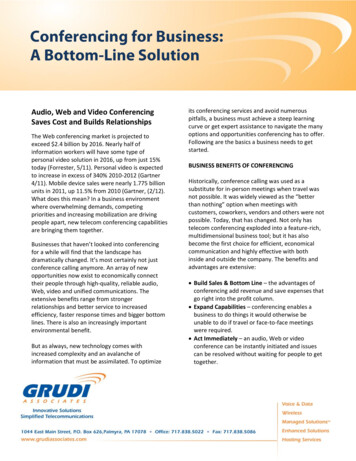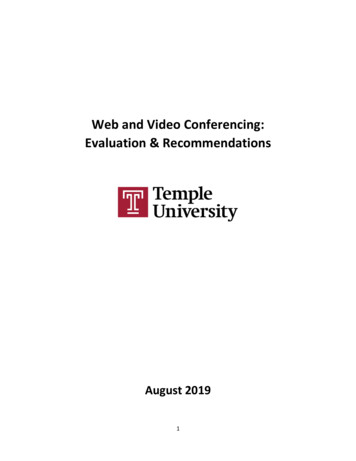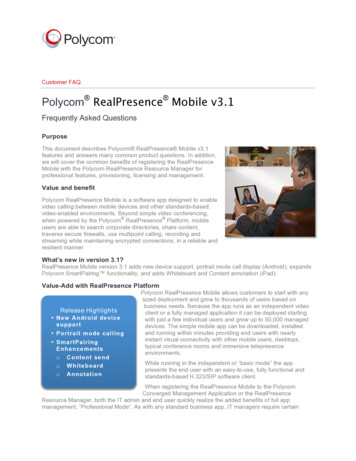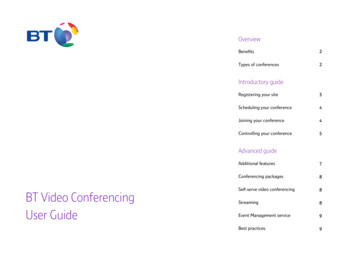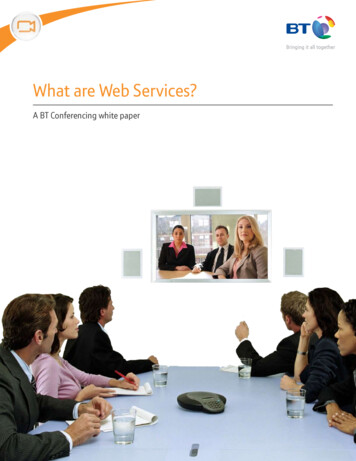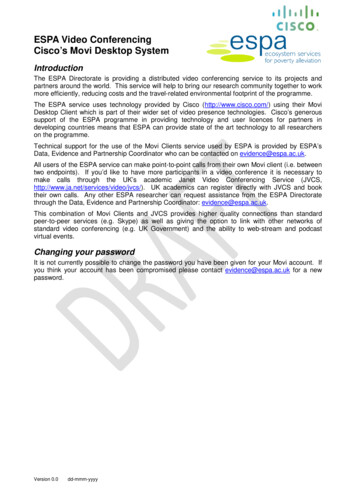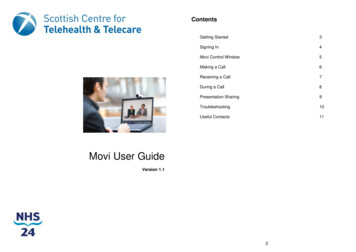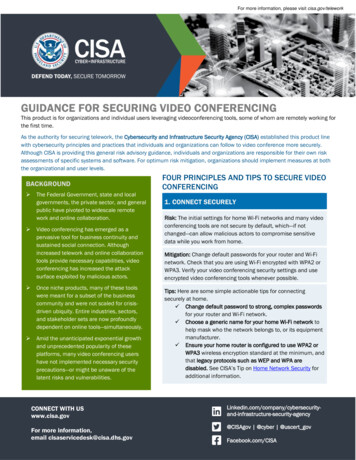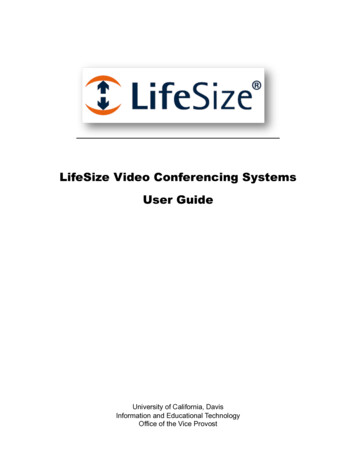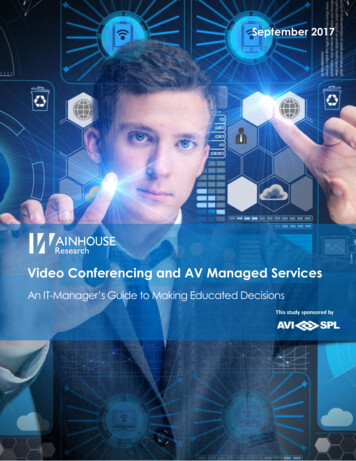
Transcription
September 2017Video Conferencing and AV Managed ServicesAn IT-Manager’s Guide to Making Educated DecisionsThis study sponsored by
Understanding Managed ServicesManaged services are not new. In fact, providers have been offering managed services – in one form oranother in various industries – for more than 25 years. And for good reason. Managed services offerkey benefits for customers and providers alike.Managed Services – The Cloud of ConfusionDespite their market tenure, managed services are commonly misunderstood by providers, prospects,and even customers.The chart above highlights just some of the elements that industry participants often associate withvideo conferencing and AV managed service offerings. From on-site staffing to account reviews to enduser training, managed services have become a catch-all for almost any support item.Managed Services - DefinitionObvious question – why does it matter? So what if managed services means something different toeach person and company, as long as the customer gets what he asks for.The problem with a vague definition is that it makes it impossible to compare offerings and makeeducated, defendable choices.So what exactly is a managed service? At Wainhouse Research (WR), we follow this definition:“A Managed Service is the outsourcing of the proactive, day-to-dayoperations management of a specific area or discipline.”Essentially, a managed service involves shifting the operational burden of a service away from theinternal service owner (e.g. an enterprise IT manager responsible for his company’s video conferencingand/or AV environment), over to an external entity / team.The focus of a managed service is the day-to-day operation of the service. So a video conferencing (VC)managed service ensures the reliability of a company’s video systems and meetings. Similarly, an AVmanaged service ensures the reliability of a company’s AV systems and meetings. Traditionally, theseservices focused on video and AV within meeting rooms only. Today, however, many providers haveexpanded their coverage to include users participating from their desks or mobile devices. 2017 Wainhouse ResearchPage 2
Note also that managed service providers should be empowered to act as appropriate to manage theservice. So instead of waiting for the internal IT manager to discover that something isn’t working, themanaged service provider (MSP) should be able to proactively discover, troubleshoot, and resolve theproblem independently – without the direct involvement of the internal service owner / customer).Minimal Requirement and Related Additional ServicesThe next most frequently asked question is, what are the minimal requirements for a managed serviceoffering? More than ten years ago, WR defined the minimum requirements for a VC / AV managedservice to be as follows:-The ability to remotely monitor and manage related technologyAccess to a properly trained, capable, and video / AV-savvy help deskDoes this mean that a managed service provider should not offer additional support services? Quite theopposite – these additional related support options can be extremely valuable to the client.Examples of some commonly offered related services include:-Meeting scheduling servicesAudio conferencing / bridging servicesVideo calling / bridging servicesStreaming / webcasting servicesEvent management / support servicesContent creationProject management servicesEquipment sales-Asset managementAV system designSystem integrationControl system programmingBreak / fix supportOnsite staffing (e.g. meet-and-greet)End-user trainingThe above shows the breadth of expertise many managed service providers (MSPs) bring to the table.However, these additional support items are not required parts of a VC / AV managed service offering.Remote vs. On-Site SupportIn the past, on-site support staff were the core of most VC / AV managed service offerings. The reasonfor this approach was quite simple; much of the technology could not be effectively managed remotely.In some cases, the devices themselves lacked IP management capability. In other cases, the customerwas unable or unwilling to give the service provider the required access to the enterprise network. Tocircumvent these issues, providers placed technical staff on the customers’ premises.Today, basically all visual collaboration tools offer remote management options.Today, however, the situation is quite different in that basically all visual collaboration tools now offerremote management options. In addition, many AV devices now support remote monitoring andmanagement – either directly or via an AV control system. Furthermore, enterprises have becomeaccustomed to providing partners with network access to facilitate service delivery.As a result, the video and AV managed service market has largely shifted away from on-site staff andtoward remote support models. 2017 Wainhouse ResearchPage 3
Dispelling Common Managed Service MythsAfter many years of helping enterprise clients evaluate whether a VC / AV managed service makes sensefor their company, we’ve come across a few common myths that should be addressed:1) Responsibility Accountability – managed service providers are well suited to shoulder theresponsibility and burden of managing your VC / AV environment. However, they are not theservice owners and thus cannot be accountable for the end-result. The buck still stops with you.2) You Can “Outsource-Away” Your Issues – before a managed service provider can takeresponsibility for the success of your VC / AV environment, the environment must be stabilized.The issues that plague your service today will not just disappear when you hire an MSP.3) Managed Services Save Money – while it seems reasonable that an MSP’s incremental cost tomanage your environment would be lower than your cost to do the same thing, the reality isquite different. Providers must hire, train, and manage qualified (expensive) people, invest inand develop advanced tools and systems, and generate profit for their investors. In the end,activating a managed service provider may increase cost. Fortunately, cost savings is not themain reason to activate a managed service provider (see below for more information).Why Should a Company Use a VC / AV Managed Service Provider?Organizations should hire an MSP because they want to outsource a non-core function (e.g. video andAV management) to a team that focuses in that area, and simultaneously free their own resources tofocus on more important things.In other words, hiring a VC / AV MSP allows apharmaceutical to focus on developing,producing, and marketing drugs – not onsupporting AV meetings.Similarly, hiring an MSP allows an investmentbank to focus on raising capital, makingacquisitions, and helping customers make money– not on launching video conference calls.Organizations routinely outsource their food services, cleaning services, delivery services, and carservices to other companies that focus in these areas. The same concept applies for video conferencingand AV service management.To be clear – not every organization should outsource the management of their collaborationenvironment. In some situations, such as high security environments or companies with exceptionallycustom needs, internal management makes more sense. We do, however, believe that mostorganizations should at least consider handing off the day-to-day work to companies for whom videoand AV are a core competency. 2017 Wainhouse ResearchPage 4
Types of VC / AV MSPsWR has segmented VC / AV managed service providers into two categories: basic and advanced.Basic VC / AV Managed Service ProvidersProviders within the “basic” category use individual browser instances to remotely access, monitor, andmanage on-premises enterprise management systems and video / AV devices (see image below).This approach depends on third-party VC and/or AV management tools designed to support a singlecompany’s environment.-In the video conferencing world, commonly used on-premises management software includesthe Cisco Telepresence Management System (TMS) and Polycom RealPresence Manager (RM).-In the AV world, commonly used on-premises management software includes the AMX ResourceManagement Suite (RMS), Crestron Fusion, and Extron GlobalViewer.Basic VC / AV Managed Service Provider – Typical ArchitectureEssentially, the MSP’s staff steps into the shoes of the customer’s local support team, uses the samebasic tools, and often follows the same basic processes and procedures (with some marginalimprovements).For the actual video and AV users, the “changing of the guard” from internal to external resources oftengoes unnoticed.The main accomplishment here is the shifting of the day-to-day workload away from internal staff.However, the customer enjoys little or no efficiency or scalability benefit with this approach.The vast majority of VC / AV managed service providers fall into the basic provider category. 2017 Wainhouse ResearchPage 5
Advanced VC / AV Managed Service ProvidersProviders within the advanced category leverage additional, often internally developed or custom,software tools and systems that allow them to manage multiple customer environments within a singleunified dashboard / pane of glass.As shown below, all systems and devices under management “connect,” either directly or through thirdparty management systems, to the provider’s centralized, multi-tenant management platform.Advanced VC / AV Managed Service Provider – Typical ArchitectureWith this approach, each browser instance provides the MSP’s support person with easy access to all ofthe systems and devices under management across all customers.This single-pane-of-glass approach enables the provider to manage large numbers of devices andsystems, and gain visibility into key performance indicators and metrics, without having to pivotbetween multiple instances of multiple applications on multiple customer networks. This expeditesproblem discovery and resolution, while simultaneously reducing cost and empowering scalability.The table below highlights the fundamental differences between the two approaches. And basically alladvanced VC / AV MSPs can offer a basic managed service, but the reverse is not the case. 2017 Wainhouse ResearchPage 6
State of the MarketThe Video Conferencing Managed Services MarketThe video conferencing managed services market is relatively mature, with literally hundreds ofproviders offering some type of service.The vast majority of providers in this space are video conferencing equipment resellers offering basicvideo managed services only. These companies are typically Cisco and Polycom certified, and thus havethe knowledge and experience needed to operate Cisco and Polycom management systems.Only a handful of firms, including AVI-SPL, the sponsor of this study, offer advanced managed services.The AV Managed Services MarketThousands of AV resellers and integrators promote their ability to manage customer AV environments.But marketing hype aside, only a small number of companies have productized these capabilities into anAV managed service with a documented set of services for a defined price. And only small percentageof these offerings would meet our definition of a true AV managed service.The reason the AV managed service market has lagged behind the video market is simple --- variety.-In the video world, providers need only support a handful of video system models to cover themajority of the market. And video managed service providers typically limit their scope ofresponsibility to the video technology and systems.-In the AV world, there are thousands of devices to monitor and manage. And system designs(equipment used, signal flows, programming / configuration, etc.) vary by customer and evenroom. This variation makes cost-effective monitoring and management incredibly challenging.However, the AV managed services market is poised for strong growth thanks to strong customerdemand for turnkey AV environments, and increased use of standard AV designs by more organizations. 2017 Wainhouse ResearchPage 7
Choosing the Right ProviderThe list below includes some of the top themes and areas of consideration for enterprises seeking tooptimize their VC / AV / UC estate and potentially choose a managed service provider partner.1) Clean Your Shop First – in our experience, many end-user customers believe that hiring an MSP is aquick way to solve their longstanding VC / AV / UC issues. While true that MSPs are likely to bringskill and experience in this area, simply activating an MSP will not make the problems disappear.Instead, WR recommends that enterprises stabilize their environments to the extent possible beforesearching for and activating an MSP.2) Separate Needs vs. Wants – the first step is to document your organization’s needs, as well aswants, as they relate to VC, AV, and UC. WR has found that many end-user customers mix theirneeds and wants, and as a result find themselves challenges to find providers able to meet theirexpectations. To resolve this issue, we recommend focusing on needs first, and wants later.3) Understand What You’re Buying – to gauge the value and extensibility of the support you’ll receive,to ask the provider for information about the tools and systems used to power the managed serviceoffering. This will help you determine whether the provider is a “basic” or “advanced” provider, andthe specific features / functions being offered.4) Focus on Efficiency and Automation – in recent quarters, scale has become a key theme in the VCand AV worlds. More users doing more meetings of more types in more places than ever before. Tothat end, WR recommends that end-user customers look for MSPs that bring more to the table thansimply experienced staff. MSPs focused on efficiency and automation (e.g. automatic call launching,scheduled / automated system testing, etc.) are best positioned to deal with the large scalerequirements of
The video conferencing managed services market is relatively mature, with literally hundreds of providers offering some type of service. The vast majority of providers in this space are video conferencing equipment resellers offering basic video managed services only. These companies are typically Cisco and Polycom certified, and thus have the knowledge and experience needed to operate Cisco .
